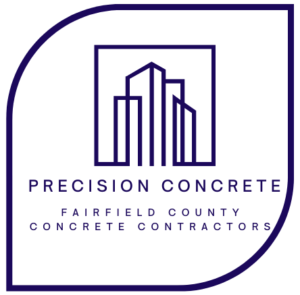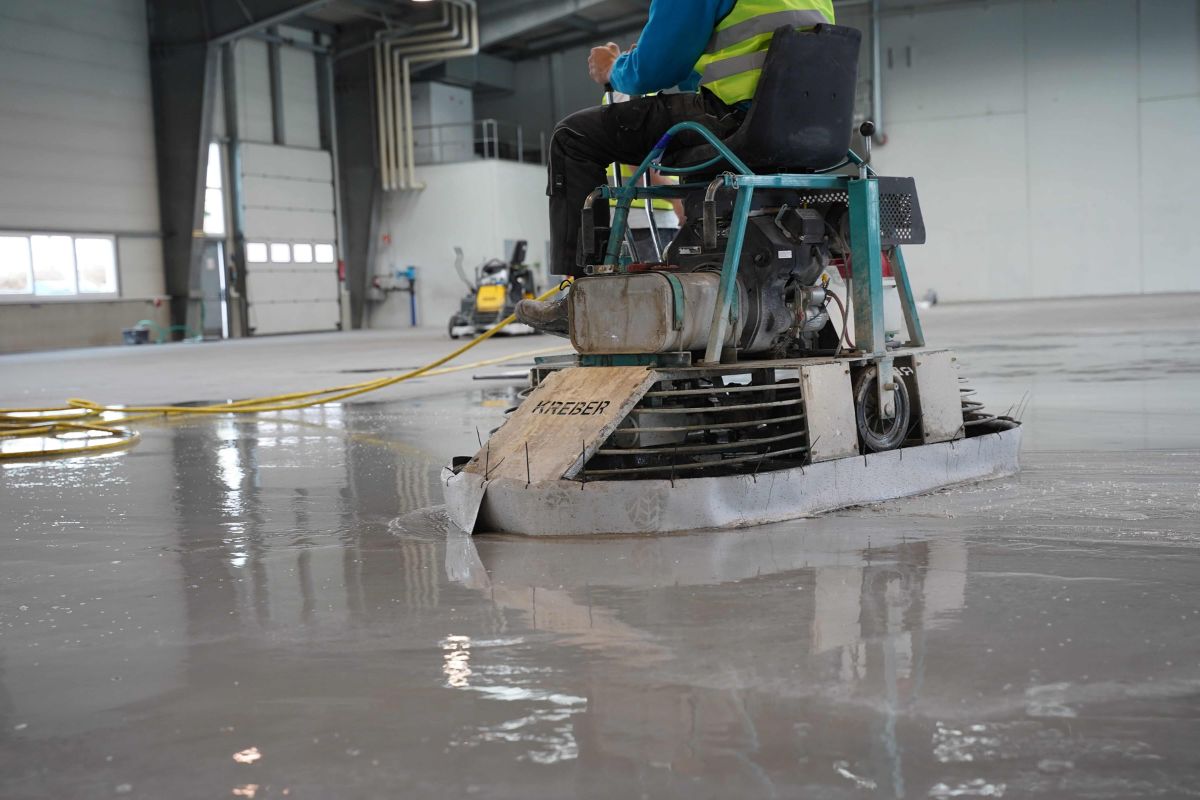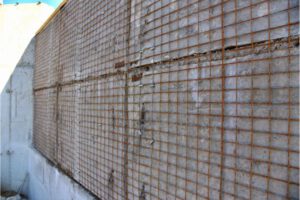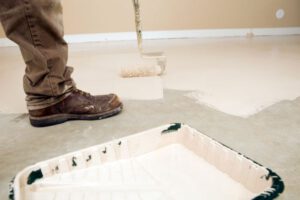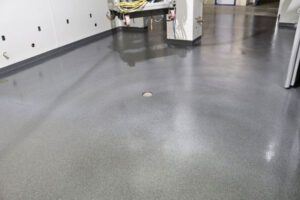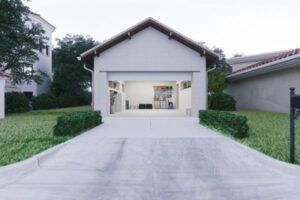Burnished concrete transforms ordinary concrete floors into shiny, high-gloss surfaces that offer both aesthetic appeal and durability. Achieved by polishing the concrete with high-speed concrete floor burnishing, this finish brings a low-maintenance yet sophisticated touch to a variety of spaces.
The process not only elevates the hardness and performance of the floor but adds a touch of class with its reflective sheen. It is a favorite among architects and constructors for both its functionality and its crisp, modern look.
If you’re curious on how burnished concrete floors can be a game-changer for your space, read on below!
What is Burnished Concrete?
Burnished concrete is a unique flooring option that sets itself apart from traditional polished concrete through its finishing process.
While both methods aim to enhance the natural beauty of concrete, burnishing achieves this through high-speed burnishing machines that heat the floor’s surface to a sheen.
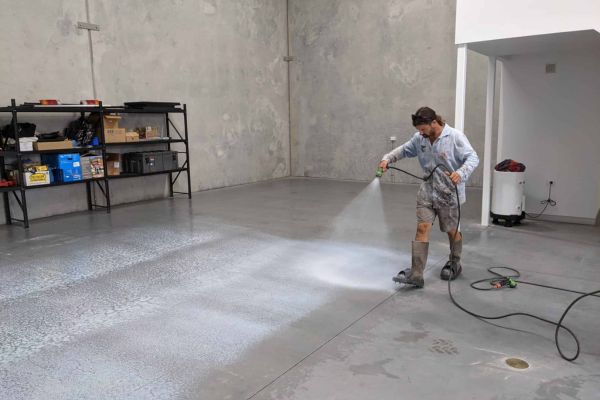
Instead of the gradual grinding that polished concrete undergoes, burnished concrete attains its smoothness and gloss in another way. This comes from the friction and heat produced by a power trowel or floor burnisher rotating at high revolutions per minute. The heat turns the concrete surface into a smooth finish that is durable and easy to maintain.
The technique results in a floor with a mirror-like finish. This achieves both aesthetic appeal and durability without the addition of a coating like wax or sealant.
Differences from Polished Concrete
Burnished concrete and polished concrete are often confused, yet they boast distinct differences, primarily in the finish and process.
Polished concrete involves multiple stages of grinding with progressively finer grades of diamond abrasives. However, burnished concrete is enhanced through a single pass of a high-speed floor burnisher that hones the surface to a high gloss.
The equipment and tools differ as well; polished concrete mandates the use of a concrete grinder and often epoxy or concrete densifier to fill in any gaps and increase the hardness of the floor.
On the other hand, a power trowel or propane-powered burnisher is used to create the smooth, reflective finish distinctive to burnished concrete without the need for additional coatings.
Pros and Cons of Burnished Concrete Floors
Burnished concrete floors has an array of considerations that span cost, appearance, durability, and maintenance. These factors collectively influence the decision-making process for architects, homeowners, and commercial cleaning companies seeking optimal flooring solutions.
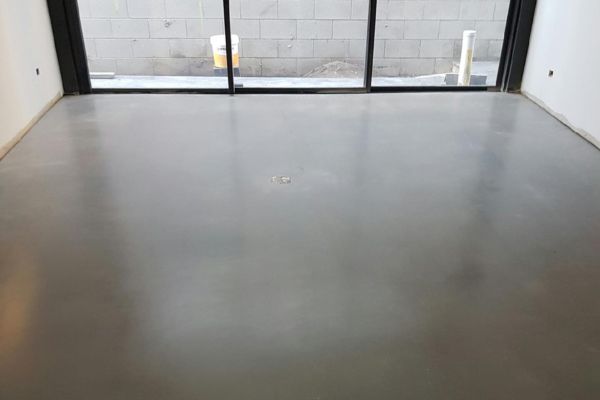
Here are the biggest pros and cons of burnished concrete floors that you might want to consider:
Cost
Price will be a major point when comparing the expenses associated with burnished concrete floors to other flooring options such as tile, wood, or carpet. Most will find it more cost-efficient, especially when considering the longevity and reduced maintenance costs. Its capacity to endure high traffic without substantial wear contributes to its economic appeal.
The initial price of installing a burnished concrete floor may vary, influenced by factors. These can include the condition of the existing concrete slab, desired gloss levels, and any decorative elements. Nevertheless, the absence of additional materials like coatings or sealants often translates into lower overall costs compared to other high-end finishes.
Appearance
Burnished concrete floors boast a sleek finish that rivals the elegance of terrazzo or marble. The high gloss achieved through burnishing not only reflects light beautifully but also conceals minor imperfections, enhancing the overall aesthetics of any space.
The visual appeal of these floors is amplified with the option to integrate color and decorative elements, such as stained patterns or embedded metal. This versatility allows burnished concrete to align seamlessly with diverse interior design themes, from industrial chic to contemporary minimalism.
Durability
Burnished concrete ranks highly in resilience when it faces everyday wear and tear. The dense surface, formed through the heat and rotational action of the burnishing process, makes it resistant to moisture ingress and stains.
In commercial settings, there is always high foot traffic. Thus, the durability of a burnished concrete finish ensures longevity. It effectively stands up to the rigors of heavy use without succumbing to dust and abrasions that floor coatings like epoxy are prone to over time.
Maintenance
Maintenance for burnished concrete floors is comparatively minimal, requiring basic cleaning with a mop and occasional passing with a floor scrubber to maintain its sheen. Regular upkeep prevents the accumulation of grime and ensures the longevity of the high-gloss surface.
Using a pH-neutral cleaner helps protect the integrity of the burnished finish, warding off damage from harsh chemicals. In high-traffic areas, periodic buffing can also be employed to restore the original luster without the reapplication of sealants or wax.
How to Achieve a Burnished Concrete Finish
Moving on to crafting a burnished concrete finish, one enters a stage where precision meets practice. Here are the steps you can follow to achieve a burnished concrete finish:
Necessary supplies
The process requires a high-performance burnisher or power trowel. These machines are critical as they generate the necessary speed and heat that yield the floor’s signature gloss.
Additionally, choosing the appropriate abrasive pads is important to achieve the desired sheen on the concrete surface. The pads must be compatible with the burnisher and be suitable for the specific hardness of the concrete being worked on.
Choosing the right machine
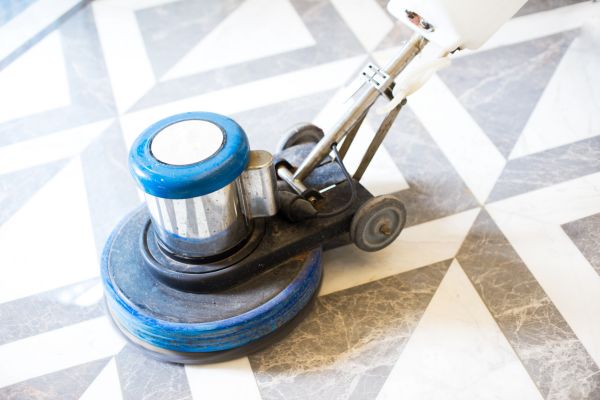
The choice of the correct burnishing tool is crucial for achieving the desired gloss on concrete floors. It depends on factors like the concrete’s hardness, the size of the area, and the machine’s power source. Options will range from electric to propane-driven systems providing flexibility for different project needs.
Professionals often choose high-speed burnishers with the strength to produce ample heat and friction required for burnished concrete finishes. Critical attributes such as weight distribution, rpm capabilities, and the quality of the burnishing pads define the equipment’s effectiveness and the resultant shine on the concrete surface.
Preparing the area
Preparing the area is a critical first step in achieving an impeccable burnished concrete finish. It involves thorough cleaning of the concrete slab to remove any dust, debris or oil that could impede the burnishing process.
Once the floor is clean, any noticeable cracks or damage should be repaired. The concrete must be allowed to dry fully before proceeding with the high-speed buffing. This will ensure a uniform and smooth finish without blemishes or defects in the final surface look and feel.
Burnishing the process
Burnishing concrete requires precision and control as the burnisher swiftly passes over the concrete slab. The operator must consistently move the machine in a uniform pattern to avoid uneven gloss and ensure complete coverage of the surface. It takes a lot of skill to achieve a proper burnishing finish which is why this should always be left in the hands of experienced professionals.
During the process, the burnisher’s pads interact with the concrete at high speeds. This will generate the heat and friction pivotal to producing a smooth, high-gloss finish. This technique eliminates the need for additional coatings, revealing the inherent beauty of the concrete beneath.
Clean up
After the burnishing process, the clean-up phase is crucial for both aesthetic and practical reasons. It involves removing any residual dust or particles that have settled during the burnishing. This step ensures the newly burnished surface remains pristine and free from any substances that could detract from its glossy appearance.
Cleaning should be thorough yet gentle to prevent any damage to the burnished finish. The use of a wet floor scrubber or damp mop with a mild cleaner can effectively capture any leftover dust without compromising the floor’s luster. Once the floor is cleaned and dried the true shine and aesthetic appeal can be seen and enjoyed.
How to Maintain a Burnished Concrete Floor
Maintaining the sleek appearance and durability of a burnished concrete floor hinges on diligent care and preventative measures. Below are some tips on maintaining a burnished concrete floor:
Regular cleaning
Effective regular cleaning is pivotal in maintaining the pristine condition of a burnished concrete floor. Using a dust mop daily will eliminate surface particles and minimize the accumulation of debris that could scratch or dull the surface.

For a more thorough weekly cleanse, a floor scrubber with a soft-bristle attachment and a PH-neutral cleaning solution can remove tougher grime. This routine preserves the floor’s gloss and extends its lifespan, reinforcing its resistance to everyday wear.
Repairing any damages
Minor cracks or chips should be filled with a concrete mix matched to the existing floor’s color and texture, ensuring a seamless repair that blends with the overall finish. Minor scuffs and damages can be fixed easily but if they are allowed to go unchecked they can quickly grow into bigger and more serious issues.
Deeper gouges or substantial damage may require the expertise of a concrete professional who can apply a resin-infused patching compound. This restores the surface to its original smoothness, allowing the burnished gloss to shine through uniformly once again. Any repair work is best left in the hands of skilled professionals who can get your floors back to their original like-new shine.
Sealing
This proactive step locks in the floor’s aesthetic appeal and preserves the strength of the concrete’s outer layer, safeguarding it against further abrasion and wear. It keeps the floors looking good and also helps add to the longevity of the floor and cuts down on major repair work.
Sealer application is straightforward, often involving a rolling or spraying method followed by a level spreading with a trowel to ensure even coverage. Once cured, the sealer acts as an invisible barrier, extending the floor’s lifespan and retaining its high gloss and smooth texture for years to come.
Conclusion
Burnished concrete floors represent a sustainable and cost-effective solution for both residential and commercial concrete applications. Their resilience and low maintenance requirements make them a smart choice for high-traffic areas. With proper care, these floors continue to offer aesthetic value and functional longevity.
From its straightforward process to its remarkable end result, the burnished concrete technique provides an exceptional floor finish. Achieving the desired gloss and texture requires precision, but it’s an attainable goal with the right tools and knowledge.
Maintenance for these gleaming surfaces is straightforward, involving routine cleaning and the occasional resealing to preserve their quality. The absence of complex upkeep stands out as a key benefit of choosing a burnished concrete floor.
Overall, concrete floor burnishing is a technique that yields a high-value finish with enduring gloss, simplicity in maintenance, and impressive durability. It is an investment that pays off in both the short-term appearance and long-term performance of the floor.
